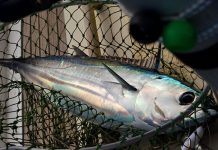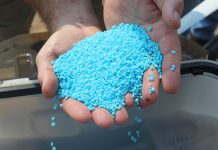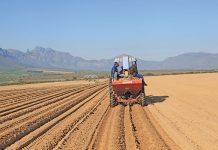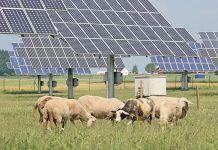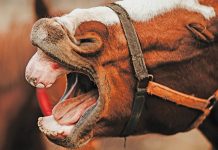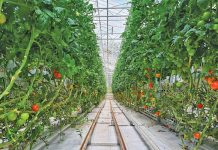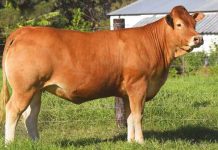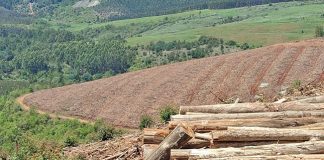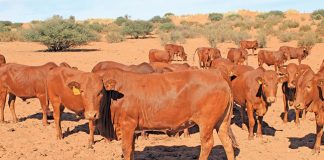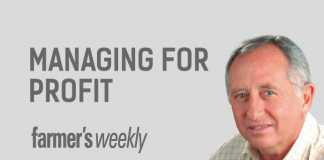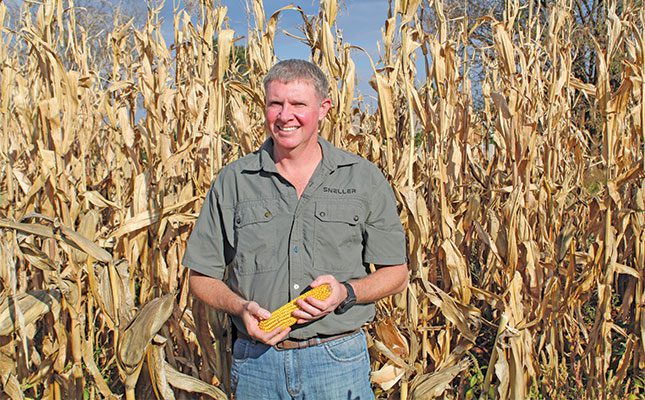
Photo: Lindi Botha
Johann Pistorius was never that interested in crops. Growing up on a diversified farm in the Nigel region of Gauteng, his first love was cattle.
“I had no interest in gambling, – placing a seed in the soil and hoping it will give you a return on investment,” he quips.
But debilitating stock theft left him with little choice. After completing his studies in animal science in 2004, he returned to the family farm where he first farmed with his father and later bought his own land. Cattle and sheep were farmed and at the peak, the feedlot had capacity for 4 000 lambs.
Theft had already plagued the farm before the COVID-19 pandemic struck, but by 2020 Pistorius was losing up to 100 lambs a week.
“I hardly slept at night because all I did was guard sheep. Having security guards was not enough – the thieves just kept on coming.”
The sheep were all sold, and while today the farm has a commercial Bonsmara herd, the focus is largely on dryland maize and soya bean. Cattle theft is still problematic but by using GPS and long-distance Bluetooth ear tags to track the cattle’s movement, losses are reduced.
Technology has, to a large extent, been the farm’s saving grace. Pistorius relies heavily on key tools to take the guesswork out of crop farming. “In my father’s day, we would speak about ‘closing the farm gate’ in December. You’d finish up planting and spray applications at the end of the year and then wait until harvest to get back to work again.
“Today, the time I spend managing the crops has doubled. With the advent of new technology and research, there are myriad things that can be done at every stage of the crop’s life to maximise yields rather than leaving it to chance. There is also far more data that can be collected and interpreted.”
Removing the guesswork
A yield map and precision equipment are two technologies Pistorius can’t go without.
“If you have loans to repay, you can’t afford to guess,” he says.
He uses AgLeader Precision technology to provide the yield map that is the starting point for his management practices for the next four seasons. Inputs are applied at varying rates according to the potential of a particular spot in the field, based on previous years’ yields, and soil analysis.
“There is never an equal yield across an entire field because there will always be differences in soil type and depth. In one spot, I’ll get 3t/ha (of maize) and in another spot 100m away, I’ll get 12t/ha.
Soil analysis
Doing soil analysis on those areas shows that there are low- and high-potential soils. Adding more fertiliser to the former will not solve the problem but instead will harm the soil. Increasing the planting density will create more competition for the plants.
“Instead, I use the data to formulate a precise prescription for the field, where low-potential soils have reduced planting density and fertiliser applications, while high-potential soils get more of both. As a result, I have increased the maize yield on low-potential soils from 2t/ha to 6t/ha.”
To double-check his decisions, he selects small areas within a field where he will reduce inputs by 10% on one and increase inputs by 10% on another. After harvest, if any of these areas outperform the main field, then he has a better idea how to formulate his prescription the next year.
He cautions against applying extra fertiliser to gain maximum yield.
“You can bankrupt yourself by adding more fertiliser to achieve record harvests. Maximum yield does not always mean maximum profit. Instead, I seek to find the sweet spot in the margin where the money spent on fertiliser and the income from the yield is maximised. This can mean the yield is lower, but so is the fertiliser bill.”
Pistorius has doubled his yields over the past three years, going from 1,4t/ha to
3t/ha on the soya bean and from 4t/ha to 9t/ha on maize. Although technology has played a massive role, a turnaround strategy based on solid advice has been invaluable.
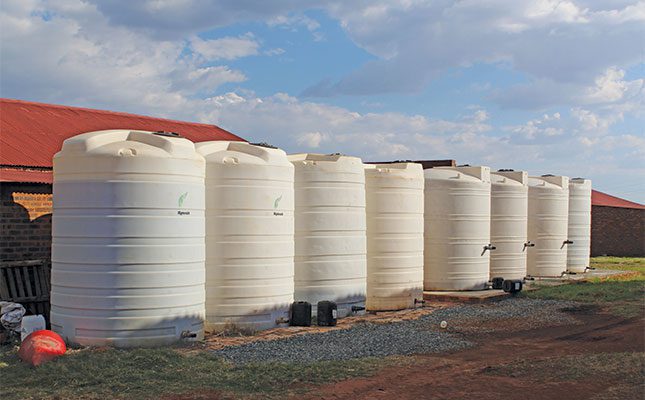
The right advice
Two years after Pistorius expanded crop production after reducing his livestock component, he came to the realisation that in crop farming, you either do it 100% correct or you leave it.
“There are no shortcuts, especially when you have a loan to repay,” he says.
Pistorius says his ‘wake-up call’ came when, one year, farming conditions were particularly good.
“Rain was ample and fell evenly across the whole region. But my neighbours were harvesting far higher yields than I was. I realised that I’d start falling behind on loan repayments very quickly if I didn’t up my game.”
Having never spent much time on crop farming, he started looking for a farmer in the area whom he could go to for advice. He crossed paths with Danie Bester, a renowned crop farmer in Balfour, Mpumalanga.
“I quickly realised that taking advice from sales people was not the way to go. They often don’t have in-depth knowledge, but most of all, they are there to sell a product, not help you farm. If you fail, they will sell products to the next guy that takes over the farm. There is no real vested interest in seeing you succeed, so why would you take their advice?”
Based on this realisation, and advice from Bester, Pistorius started cutting down on his inputs.
“Previously, I’d be concerned over weed emergence in my soya bean fields. The salesperson would tell me to apply double the dose of herbicide. It’s not only expensive, but off-label. When I stopped those applications, my soya bean did far better. The seeds might be herbicide resistant, but they do take a knock when there are too many herbicide applications when the plants are still small.”
A change in cultivar was another important lesson.
“My father stuck to one brand and that’s what I started using. But Bester advised me to plant my own trials to see what truly worked best on my farm. As a result, I switched brands because there were other cultivars that outperformed what we were traditionally using.”
The first year that Pistorius implemented Bester’s advice was a particularly dry one, with the area receiving around half of the normal rainfall. However, his yields rose despite the challenging weather. And this while his fertiliser and herbicide applications, and planting density were reduced.
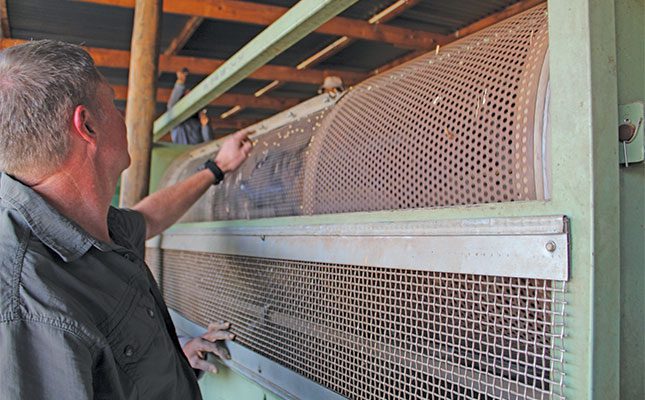
Soil health
Reducing fertiliser to get better yields may sound counterintuitive, but it was a crucial step to improve soil health.
The land Pistorius bought was previously used for silage, which can deplete soil over time if not correctly managed. Soil is heavily compacted in the harvesting and transport phase, while the removal of all plant material means that there is no build-up of organic matter crucial for soil health.
The poor soil meant that his soya bean yields averaged 1,2t/ha, whereas his grandfather would achieve 4t/ha on an adjacent farm.
Addressing compaction first, the land was ripped to a depth of 150mm. He then realised that at 600mm there was another compaction layer as a result of incorrect fertiliser management.
“There was a build-up of acidity and salt as a result of applying too much fertiliser. Crucial soil microbes can’t survive in such soils, which negatively impacts both nutrient uptake in plants and the rate at which plant matter is broken down in the soil.”
After loosening the soil mechanically, the next step in rectifying such soils is therefore building the microbial population. Pistorius plants stooling rye and oats as cover crops after harvest. These plant roots provide ongoing feed for microbes while absorbing some of the salt in the soils. Lime and humates are also applied regularly.
But he laments that the quality of humates available in South Africa is inferior to those available in the US.
“So, it takes much longer to see results. Initially I applied 2ℓ/ha in the furrow at planting, but I doubled it last year. Ideally, I’d like to add even more, but it would be best to get the right products first.”
He states that microbes are tricky to manage, since populations need to be increased over time.
“There has been limited success with adding microbes from external sources. Measuring what you have is also not easy since soil samples need to be sent abroad. All one can do is ensure they have an optimal environment in which to flourish. But that means reducing fertiliser applications, which can only be done up to a point before you start losing yield.”
Pistorius has an added problem in that the harsh Highveld winter limits his cover crop choices.
“There are crops like legumes that can do much more to feed the soil than rye and oats, but they won’t survive here.”
Strip-till and no-till practices are followed on the farm to reduce soil disturbance, although lime applications are still ploughed into the soil.
One of the reasons he still keeps a herd of cattle is so that they can graze the crop fields, adding valuable manure and urine that aid soil health. He has just bought a manure spreader to increase the amount of manure applied to the fields, which should also yield better results in time.
While it’s a slow process to nurse the soil back to health, Pistorius has seen benefits. His fertiliser applications have been reduced by at least 100kg/ha while yields have increased.
In contemplating future progress, he refers to US farmer Kevin Kalb, renowned for his record-breaking maize yields of 20t/ha.
“I’m not even halfway there yet! But Kevin has been managing his soil correctly for 30 years, while I have only been at it for five,” says Pistorius.
“They have better humates, and organic content of their soils is 10 times that in South Africa, but there is still a lot of room for us to grow.”
The key factor in everything remains soil health, says Pistorius. He adds that he believes that while technology has developed as much as it can, with its level of precision being only second to the military, it is biology improvements that bring the greatest advancements in the years ahead.
“The worse you treat the soil, the faster you will go bankrupt. So, whatever you do, ensure that what you do this season leaves the soil in a better state for next season.”
Email Johann Pistorius at [email protected].

